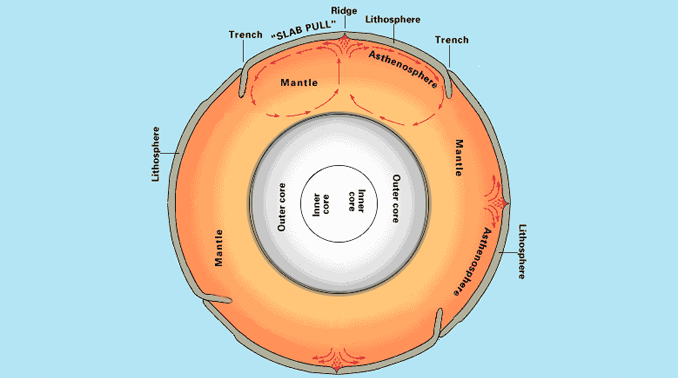

Under the rigid layer of rock we live on, the Earth’s asthenosphere is like dense plastic.
Because of its fluid-like properties, mantle convection can occur. Then, mantle convection is the main driver of plate tectonics.
And it’s because of convection deep down beneath our feet that we have volcanoes and earthquakes as well.
But how does mantle convection work? And how is convection related to plate tectonics and moving continents?
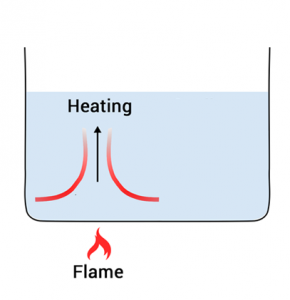
Imagine you are boiling water in a pot. If you boil one side of the pot, it will get hotter directly where the flame is.
For Earth, the heat source is radioactive isotopes deep inside the interior of Earth. Over time, they slowly release heat accounting for approximately 50% of Earth’s internal heat budget.
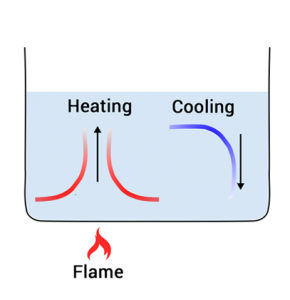
Now that we have a source of heat, we know systems always try to go into an equilibrium. For example, hot water will mix with cold water. Actually, this happens in the atmosphere with air temperature.
So far, hot water has risen to the top of the pot. But it’s even colder directly to the right. Next, the hot water will start moving to the right and mix with colder water.
CIRCULAR MOTION: Eventually, this pattern creates a circular motion. This circular motion is the convection cycle that happens inside Earth within the asthenosphere.
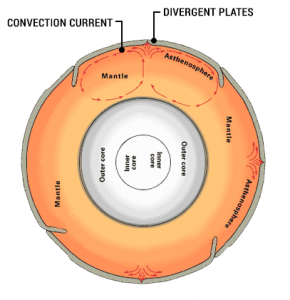
For liquids and gases, the convection cycle can happen because particles can freely flow. But in our rigid lithosphere which is a solid, particles cannot freely move.
Beneath Earth’s crust, the convection cycle is what’s happening in the mantle. Because the plastic-like “asthenosphere” acts as a liquid, it makes the convection cycle possible
Based on mantle convection, each plate tectonic moves in a specific way. For example, there are divergent, convergent and transform plates.
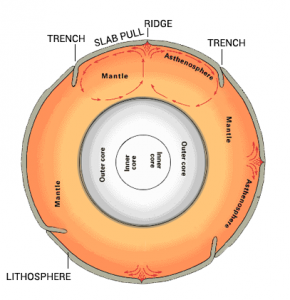
As mantle convection rises, it breaks apart the Earth to form mid-oceanic ridges (tensional force). When it sinks down, it breaks it apart (compressional force).
These tensional and compressional forces are what drive plate tectonics. They break apart the whole lithosphere into 7 major plate tectonics and 12 or so minor ones.
Now, that we know mantle convection tears the brittle lithosphere apart which is also called “slab pull”. But what happens if there’s a continent within one of these plates?
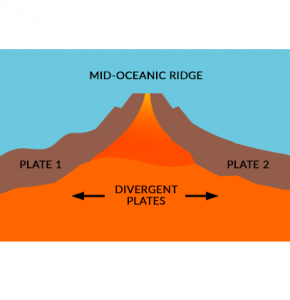
We know that plate tectonics are moving because of mantle convection. You also know that plates can diverge, converge, or slide across one another.
But how does this relate to continents? Are continents actually moving?
You should think of it as continents riding on the plate. Because the whole plate is actually moving, it’s like standing on a conveyor belt.
Is it moving? No. It’s the conveyor belt that transports the continent in the process of continental drift.
So, continents passively move on plate tectonics. And this phenomenon that’s been happening for millions of years is called continental drift.
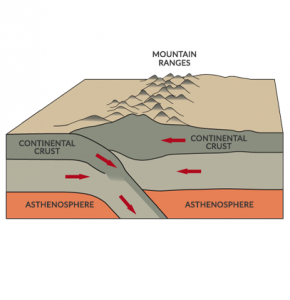
Plate tectonics helps answer what we didn’t know about volcanoes, mountains, and earthquakes.
Because plate tectonics crash into each other, this collision creates chains of mountains. All the greatest mountains in the world are the result of continents crashing into each other.
It’s the tensional and compressional forces from mantle convection that drives plate tectonics.
“Each continent rides on plate tectonics like a colossal conveyor belt. And they move about 5 to 10 centimeters per year.”
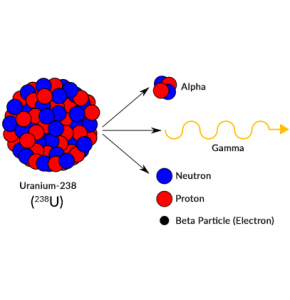
Four radioactive isotopes inside Earth account for about 50% of Earth’s internal heat.
Like a slow cooker, they constantly release heat within the planet keeping it on a light simmer.
These four isotopes generate 50% of Earth’s radiogenic heat:
The majority of internal heat transfer occurs at mid-oceanic ridges. Whereas, the least amount of heat transfer is from the continental interiors.
Mantle convection is like Earth’s engine. This process heats from the Earth’s core, mantle, and internal radioactive decay, which moves towards the surface of the Earth.
Mantle convection is a fundamental driver of tectonic plate movements. It shapes the Earth’s surface features and plays a crucial role in geological processes such as the formation of mountains and the opening of ocean basins.
If you have any questions about mantle convection, make sure you drop us a question in the comment box below.